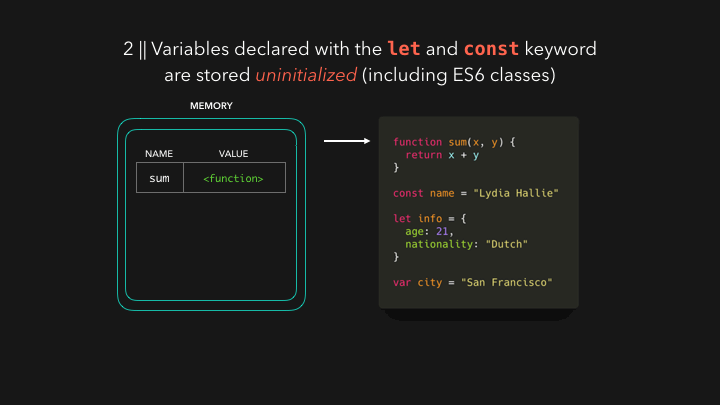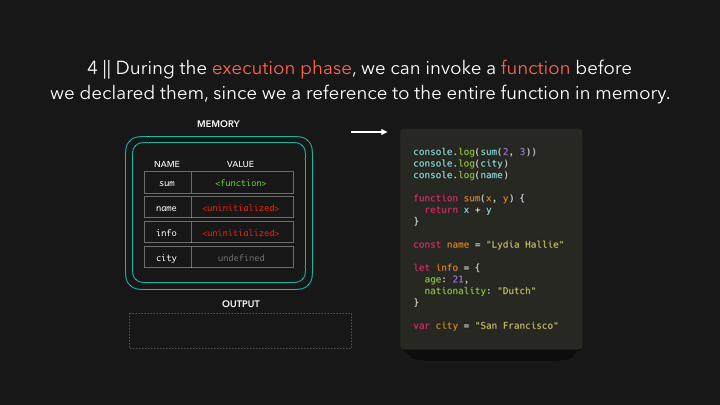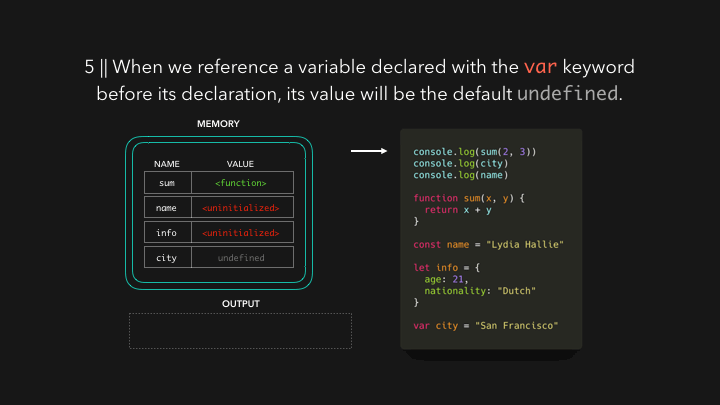Hoisting is one of those terms that every JS dev has heard of because you googled your annoying error and ended up on StackOverflow, where this person told you that this error was caused because of hoisting 🙃 So, what is hoisting? (FYI - scope will be covered in another post, I like to keep posts small and focused)
If you’re new to JavaScript, you may have experienced “weird” behavior where some variables are randomly undefined, ReferenceErrors get thrown, and so on. Hoisting is often explained as putting variables and functions to the top of the file but nah, that’s not what’s happening, although the behavior might seem like it 😃
When the JS engine gets our script, the first thing it does is setting up memory for the data in our code. No code is executed at this point, it’s simply just preparing everything for execution. The way that function declarations and variables are stored is different. Functions are stored with a reference to the entire function.
With variables, it’s a bit different. ES6 introduced two new keywords to declare variables: let and const. Variables declared with the let or const keyword are stored uninitialized.
Variables declared with the var keyword are stored with the default value of undefined.
Now that the creation phase is done, we can actually execute the code. Let's see what happens if we had 3 console.log statements on top of the file, before we declared the function or any of the variables.
Since functions are stored with a reference to the entire function code, we can invoke them even before the line on which we created them! 🔥
When we reference a variable declared with the var keyword before their declaration, it’ll simply return its default value that it was stored with: undefined! However, this could sometimes lead to "unexpected" behavior. In most cases this means you’re referencing it unintentionally (you probably don’t want it to actually have the value of undefined) 😬
In order to prevent being able to accidentally reference an undefined variable, like we could with the var keyword, a ReferenceError gets thrown whenever we try to access uninitialized variables. The "zone" before their actual declaration, is called the temporal dead zone: you cannot reference the variables (this includes ES6 classes as well!) before their initialization.
When the engine passes the line on which we actually declared the variables, the values in memory are overwritten with the values we actually declared them with.
(Oops I notice now this should be number 7. Will update asap 😬)

All done! 🎉 Quick recap:
- Functions and variables are stored in memory for an execution context before we execute our code. This is called hoisting.
- Functions are stored with a reference to the entire functions, variables with the
varkeyword with the value ofundefined, and variables with theletandconstkeyword are stored uninitialized.
I hope that the term hoisting is a bit less vague now that we've looked at what's happening when we execute our code. As always, don't worry if it still doesn't make a lot of sense yet. You'll get a lot more comfortable with it the more you work with it. Feel free to ask me for help, I'd love to help you! 😃













Top comments (55)
Your GIFs are on point! Very good article. I think most of us know or have heard about hoisting but this makes it totally clear in my head now. Keep up the good work!
It's such a simple thing to explain when looking at yours.. I wonder why so many teach the "Hoisting is often explained as putting variables and functions to the top of the file" - perhaps that's what they learned; perhaps it is the fallacy of thinking "people won't understand because it's complex".
If someone would have asked me to explain hoisting before reading this article I would fall back on that explanation but not really knowing why; now I know better! I have quite good understanding of javascript (for being a mostly C# developer - learning react) and like to know what is going on, one of my favorites in the JS world to read and listen to is Kyle Simpson ('You don't know JS' , + 'Yet') - he is awesome , but you know what.. you, Lydia, are fantastic teacher and a ⭐ on the same sky as Kyle.
I hope you take this advantage to a next level and produce courses on Udemy and/or Pluralsight - I think you could make a fortune (or at least some extra cash) on it 😄
Keep it up 💚 !
//Jimi
It's a nice refreshment to see gifs that break up the text to digestible chunks while also helping with the visualization. Keep it up!
I can see why it's described that way to some extent. Parser needs to go over the whole file/script, and it only does something meaningful with functions, and vars at first. So at the top of the file, very first line, you already have the access to those identifiers.
It’s just important to understand that the parser is not actually physically moving them to the top - as some people like to explain it
Yup I agree. Semantically it only makes difference with vars, but you descriptions are to the point 👌
Testing comment UI...
2Testing comment UI...
First things first, thank you Lydia for this amazing topic. and I've a question regarding using let.
I think let variables is initialized to with undefined. but due to being in temporal zone it's value is inaccessible.
I tried
let x;
console.log(x); // resulting >> undefind
Yes this is true... The value will be accessible only after the temp dead zone expires...
It results undefined because you have initialized the variable 'x' already but haven't defined the variable with any value. This is why it prints out undefined.
Great article! What about const function? ex. const sum = (x,y) => x+y
When it comes to const ... They should be assigned some value at the tym of declaration.... So anyway we will get an error if we try to access them b4 declaration
You may consider it as the "hoisting variable const" situation.
That's reason I love this site. I just learn JS and term hoisting was unknown for me until this moment. I read text above and resolve my doubts. Thx!
Love this entire collection, Lydia. Shared them all in my react native newsletter
Thank you for explaining how it works internally "var brings variables to top" totally makes sense now!
Thank you for sharing! deserves a lot of 🦄🦄🦄
Also, important thing that arrow functions aren't hoisted. Could be confusing one for somebody.
U knw wt, i actually came here from event loop article... Ua articles r very precise n concise... And those gifs 🙌.... I knw that they will definately save reader's tym but it wud hv taken so much tym of urs... I really appreciate the efforts..... Thanks alot!...🙏
thanks for the sharing, this is very clear.
i have an additional question. pls help
what if i just use a variable without declare them anywhere.
like this:
x = 10;
console.log(x);
is the default is "var"?
Very informative article with amazing GIFs.
How you created these GIFs. Is there any tool or created those animations first than converted to GIFs.
Hi, Lydia~ Very nice articles~ Can I translate this series articles into Chinese, I'll keep the original links~
love all of your articles, keep up the great work!
Among many superficial JavaScript tutorials and articles, this one really stands out with underlying understanding.